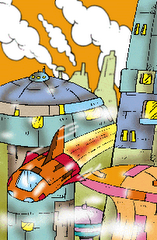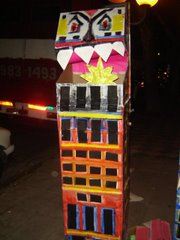Buenos Aires Residents Rebel Against Apartment Towers
By Marcela Valente
Residents fear that the Caballito neighborhood's utilities could collapse from the unregulated proliferation of apartment towers. By 2008 an estimated 40,000 more people will live in the district.
BUENOS AIRES, Dec 11 (Tierramérica) - Upset with the multiplication of apartment towers in neighborhoods of single-family dwellings, residents in Buenos Aires are calling for a halt to unregulated construction that threatens to push water and sanitation services to the brink of collapse and leave the city without green spaces. The epicenter of the phenomenon is the central neighborhood of Caballito, where 15.4 percent of all new buildings were built in the January-August period, although the district covers just three percent of the capital's total area. In contrast, in 14 neighborhoods in the southern part of the city, which cover 11 times the area, just three percent of new construction occurred. "They want to bury us under the cement," protested Gustavo Desplats, leader of Proto Comuna Caballito, an umbrella of more than 20 neighborhood groups and part of the broader Green Citizen Network, in a Tierramérica interview. The movement emerged in June with a demonstration by 40 Caballito residents. But by December they had reached protest number 15, which drew participation by thousands of people from different neighborhoods. The neighbors issue calls to make noise on various streetcorners, to march wearing facemasks to protest air pollution, or to set up barricades around apartment towers under construction in the middle of residential districts. Now the demand is for balance in urban development. The residents point to what they see as a lack of a strategic plan. They say the existing regulations are obsolete and the investors are the ones who decide, without concern for whether the apartment towers are being built in areas of single houses or whether there is sufficient infrastructure to maintain the capacity of public utilities. "It's a dynamic that tears the social fabric, creating ghettos in neighborhoods with luxury apartment towers and pushing out middle class residents, who undergo a process of marginalization," said Desplats. To put the brakes on the phenomenon, they call for suspending construction and creating a government body that coordinates the growth of the entire urban core, with resident participation. "If the state doesn't intervene, the growth gap between neighborhoods will be greater and greater," said Desplats. According to figures from the National Statistics and Census Institute, in the city of Buenos Aires live 2.7 million people.
But the entire metropolitan area is home to 12 million. Between January and October of this year, the number of construction permit applications filed with the city government was up 48 percent with respect to the same period in 2005. This growth indicator has been on the rise since the currency devaluation of 2002, when construction became a safe bet as an alternative investment. City lawmaker Beatriz Baltroc, of the governing Front for Victory, told Tierramérica "there is unchecked growth", and proposed stricter regulations for apartment construction. Desplats also noted, "We are one of the Buenos Aires neighborhoods with worst environmental and noise pollution, and we are still the ones with greatest real estate investments." This is due to the district's strategic location in the center of the city. But the neighborhood is not prepared for the avalanche of development. In Buenos Aires overall, there are 15,000 people per square kilometer. But in Caballito there are 28,000 people per square kilometer -- and the World Health Organization recommends a maximum of 20,000. As for urban green spaces, WHO suggests 12 to 15 square meters per inhabitant. Caballito has barely 1.3 square meters per person. The neighborhood operates with water and sanitation services built in 1911 for an area of estates where 25,000 people lived. Now it has 190,000 residents, and with the new apartment towers will be seeing 40,000 more before the end of 2008. There are many complaints from residents about the lack of water pressure or basements being flooded with sewage. The neighborhood movement made a big impact in November when the courts accepted a request for protection that would halt construction of apartment towers on 16 blocks until a study ensures that public services won't collapse. A decree from the city government put a 90-day stay on building permits in the six neighborhoods with fastest growth in Buenos Aires.
The construction companies were up in arms, but that only seemed to strengthen the resolve of the residents. Osvaldo Sidoli, attorney with the Green Citizen Network and responsible for the legal filing that halted construction, told Tierramérica that another has been filed, targeting building in other parts of Caballito, one in Villa Pueyrredón and two in Palermo. "We don't want to stop construction (of towers of more than 2,500 square meters), but rather to ensure that there are public hearings involving the residents, as the law stipulates, and that the corresponding environmental impact studies are carried out," said Sidoli. "There are contractors who on the same block build two towers at 1,250 square meters each, to avoid having to comply with the requirements," he added.







No hay comentarios.:
Publicar un comentario